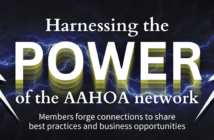Human trafficking deprives people of their basic rights, but the hospitality industry can lend a hand in helping stop these crimes.
by BRANDON VERVELDE
It happens all around you, in large cities, quaint suburbs and cozy towns. It does not look like what you think. Their ages range from young children to adults, even those you could call senior citizens. It is women and girls mostly, but men and boys are not immune. Some are poor, and some are rich. Some are homeless or runaways. Some are refugees from war-torn countries. Some were victims of domestic violence, but now are victims of a new form of violence, usurpation, exploitation, and physical and mental manipulation.
It is human trafficking; slavery in the 21st century. It is not an HBO special or a historical docu-drama on the History Channel. It is real life.
MODERN SLAVERY
Human trafficking enslaves more than 20 million people worldwide, depriving them of their right to freedom. President Barack Obama called human trafficking a “violation of human decency,” and President Donald J. Trump called it a “horrific practice.” Since 2011, January has been declared National Slavery and Human Trafficking Prevention Month.
Unlike the slavery of centuries past, the victims do not appear in physical chains. Instead, their chains are physical and sexual assaults, mental and emotional manipulation, confiscation of passports and other identification, insurmountable financial debts and fear of retribution.
Broadly, human trafficking is easy to understand and define. The United Nations uses a three-element definition of human trafficking: the act, the means and the purpose.
The elements of the UN definition are easier to put into words than to spot in the real world, however. This deficiency led the Polaris Project, a Washington, D.C.-based non-profit group that is leading the global fight against human trafficking, to study trafficking from a different perspective.
For years, researchers have struggled with little or incomplete data on the prevalence and details of human trafficking. Polaris’s unique focus on technology to fight human trafficking presented an opportunity. They operate the National Human Trafficking Hotline and an anti-trafficking texting service, called the BeFree Textline. Their researchers analyzed more than 32,000 cases of human trafficking from all angles – profiling the victims, the perpetrators and the tactics used across all the cases. It was the largest analysis of human trafficking data in history.
Their 2017 report broke all of the preconceptions one might have about what human trafficking looks like and how it works.
The data revealed 25 distinct classifications of human trafficking. Each has its own unique criminal modus operandi – from recruitment and entrapment to manipulation and victim profiles. Dozens of strategies and tactics were found, revealing the extent that human trafficking has evolved and become even more devastating in its potency.
“The Typology of Modern Slavery offers a new map to understand how human trafficking manifests throughout the country,” said Polaris CEO, Bradley Myles.
The 25 types of human trafficking fall into one of two broad categories, labor trafficking and sex trafficking, though Polaris researchers point out that frequently victims are trafficked in several ways and their method of enslavement can change. Labor trafficking is also widely underreported, the researchers believe, because the victims are unaware they are a victim of a crime or that help is available.
STOPPING HUMAN TRAFFICKING
One goal of the Polaris report was to thoroughly study human trafficking so that vulnerabilities in traffickers’ strategies and tactics would emerge. The report helped researchers, and now the general public and anti-trafficking advocates, “understand the ways that traffickers leverage and exploit legitimate businesses or institutions – such as social media, hotels, financial institutions, transportation systems and government visas.”
“With this greater understanding, we can begin to develop strategic campaigns to spur systematic action, unite disparate efforts, allocate limited resources and facilitate effective interventions to combat the crime,” the researchers wrote.
Myles believes that one way to combat the crime is to cut into traffickers’ monetary gains.
“If you think of trafficking as a business, traffickers have perceived that they can make a high profit at a very low risk,” he said. “The strategy with this report is to start to flip that equation: How do we decrease traffickers’ perception of profit? How do we increase their sense of risk?”
The International Labor Organization believes that worldwide profits from just forced labor trafficking are in the range of $150 billion annually. Other sources are skeptical of putting numbers on it because the data is so spotty, but agree that traffickers profit massively from their victims.
To cut into their ill-gotten gains, advocates have emphasized specialized training – rather than generic training – that focuses on the types of trafficking that the audience might encounter. For example, the Polaris report points out that some human traffickers use hotels, but not all. A training for hotel owners and staff should focus only on the ways to spot and prevent human trafficking types that might occur in hotels and not the types that occur elsewhere.
That is why the Asian American Hotel Owners Association (AAHOA) partnered this summer with the U.S. Department of Homeland Security’s anti-trafficking Blue Campaign. The department launched the Blue Campaign a few years ago to unify resources within the vast government agency to a single public outlet.
As an official partner in the Blue Campaign, AAHOA is working with government officials to produce hospitality-specific training materials for hotel owners and every member of a hotel’s staff. The goal is to equip everyone in the hospitality industry with the tools to combat the scourge of human trafficking.
“Education is a foundational pillar of our organization,” said AAHOA President and CEO Chip Rogers. “We’re thankful to be able to partner with the Department of Homeland Security on the Blue Campaign and use our association’s array of resources and tools to bring hoteliers up to speed on this horrible crime and how they and their staff members can bring an end to it, one property at a time.”
The Blue Campaign is just one aspect of AAHOA’s efforts so far on fighting human trafficking. At the national convention in San Antonio in April, AAHOA organized an education session on combatting human trafficking and brought in experts, who included a former Department of Homeland Security official and Dr. Mar Brettman, a former professor and founder of Businesses Ending Slavery and Trafficking, or BEST. They have also launched a webpage dedicated to housing resources, along with including information at nearly every one of the more than 150 events per year that AAHOA hosts.
LEGISLATIVE ACTION
Because of human trafficking’s complexity and ever-changing strategies and tactics, lawmakers are finding that legislative solutions are not easy to find. For example, most individual actions committed by the perpetrators of trafficking are already illegal. Individuals in positions to spot the signs are the only way to expose the crimes to the authorities and make arrests and prosecutions, Myles suggests.
Earlier this year, the House of Representatives passed more than a dozen bills on a bipartisan basis to help stop human trafficking, almost all of them focused on raising awareness and educating people in positions to help spot the signs, hotels included. One bill mandated that federal agencies prioritize hotels for government travel that have robust anti-trafficking programs in place.
The spending power of the federal government could be a powerful incentive for hoteliers to be more proactive, but that should not be their only motivation, said AAHOA Chairman Bhavesh Patel.
“AAHOA members have a moral and legal obligation to take action,” Patel has said. “Hoteliers are uniquely positioned to help detect, combat and prevent this insidious practice.”
To do your part in eliminating human trafficking, log on to aahoa.com/humantraffickingresources. ■
THE 25 TYPES OF HUMAN TRAFFICKING
- Escort services
- Illicit massage, health and beauty
- Outdoor solicitation
- Residential
- Domestic work
- Bars, strip clubs and cantinas
- Pornography
- Traveling sales crews
- Restaurants and food service
- Peddling and begging
- Agriculture and animal husbandry
- Personal sexual servitude
- Health and beauty services
- Construction
- Hotels and hospitality
- Landscaping
- Illicit activities
- Arts and entertainment
- Commercial cleaning services
- Factories and manufacturing
- Remote interactive sexual acts
- Carnivals
- Forestry and logging
- Health care
- Recreational facilities
Source: The Typology of Modern Slavery, Polaris, March 2017
Photo credit: 271 EAK MOTO/Shutterstock.com




